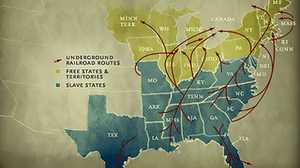The Battle of Fredericksburg

Throughout much of the Civil War, a key Union objective was to penetrate the South and seize the city of Richmond, Virginia, the capital of the Confederacy. In order to take the city, Union troops had to cross the Rappahannock River. Union forces would make an attempt in November of 1863 under the leadership of newly appointed General Ambrose Burnside. Burnside's plan was to cross the river quickly at Fredericksburg, Virginia, surprising General Robert E. Lee's Confederate army, and proceed 35 miles to Richmond. General Burnside's campaign at Fredericksburg did not go as planned, in part because the battle introduced obstacles his men had never before encountered.
1. Communication
General Burnside's troops reach the Rappahannock River to find that the pontoons they need to cross the river have not arrived. Poor communication and inclement weather have hampered the delivery. Burnside's men wait almost two weeks for the equipment to show up. The quick advance of Union troops on General Lee's unsuspecting army is an essential part of Burnside's strategy; the two-week delay gives the Confederate soldiers plenty of time to prepare for battle.
2. Pontoon Bridges
Bridging the Rappahannock River is a formidable, all-day task for Union troops. As pontoniers begin construction on the morning of December 11, Confederate sharpshooters open fire. Union artillery at Stafford Heights aids the Federals in their advance, but Rebel resistance is strong. Union troops eventually make it across, but not before valuable hours pass and hundreds of soldiers are killed.
3. Urban Warfare
Confederate soldiers, hiding behind buildings and inside houses, attack Burnside's men, who are advancing into the town of Fredericksburg. Union troops are unable to consolidate in the town and a fierce street fight ensues. Urban warfare such as this was uncommon during the Civil War.
4. Fortifications
Lee does not entirely resist the advance of Burnside's army. He wants the Federals to cross the river and be forced to traverse the open terrain leading to Marye's Heights, where his army awaits. At the base of the heights is a stone wall, behind which Confederate troops are arranged in rows, one row reinforcing the next. The concentrated fire from behind this fortification keeps the Union soldiers from within 30-40 feet of the wall. Thousands of Union soldiers are killed, thus ending Burnside's campaign.
5. Rifled Musket
Union and Confederate troops make use of the rifled musket, which can be fired and reloaded rapidly. This new weapon makes waging war more efficient. The bullets it fires are cone-shaped, increasing the range and accuracy of each shot. From behind their fortifications, the Confederate forces at Fredericksburg assault the approaching Federals with round after round of deadly fire.







